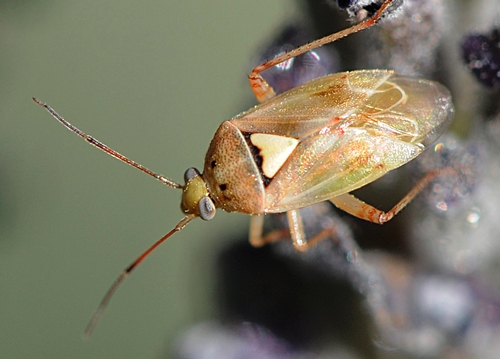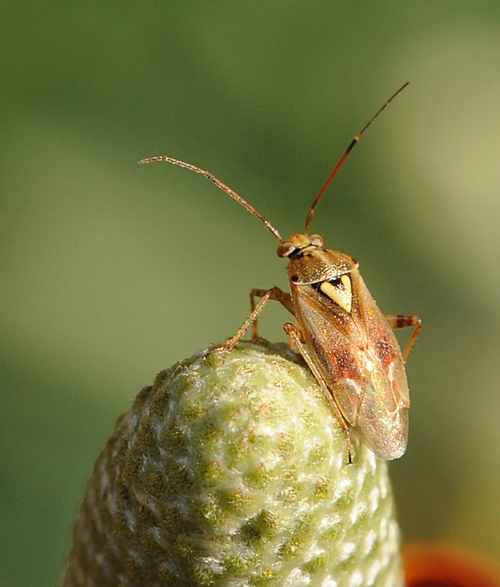- Author: Kathy Keatley Garvey

At a recent visit to the UC Davis Ecological Garden at the Student Farm, we watched a honey bee, Apis mellifera, and a lygus bug nymph, Lygus hesperus, foraging on a batchelor button, Centaurea cyanus.
The bee: the beneficial insect.
The lygus bug or Western tarnished plant bug: a pest.
The lygus bug, which punctures plant tissues with its piercing mouthparts, was there first, but no matter. The bee joined in, edging closer and closer until they touched.
In photography insect circles, that's a "two-for"--two insects in one image.
The bee finally buzzed off, leaving the lygus bug to "dine" alone.
The lygus bug, distinguished by a conspicuous triangle on its back, is a very serious pest of cotton, strawberries and seed crops, including alfalfa. Scientists estimate that in California alone, the pest causes $30 million in damage to cotton plants each year, and at least $40 million in losses to the state's strawberry industry. The insect is also a pest of numerous fruits and vegetables, including apples, pears, peaches, eggplant, tomato, potato, artichoke, lettuce, sugarbeet, and beans. See what the UC Statewide Integrated Pest Management Program (UC IPM), says about the pest.
What do they look like? "Adult lygus bugs are green, straw yellow, or brown with a conspicuous yellow or pale green triangle on their backs," UC IPM says. "Nymphs are light green...Lygus can move into gardens or orchards from weeds, especially when they dry up. They are a particular problem in beans, strawberries, and orchard crops, feeding on developing flower buds and fruit. Fruit may become blemished and discolored, deformed, or twisted and may develop depressions or pustules."
Cotton? "Lygus bugs," says UC IPM, "migrate to cotton from other hosts, so management of this pest begins with assessing its populations outside the field. Check for them on weeds, in nearby alfalfa, and in other crops, and keep in touch with your pest control adviser, Extension agent or Farm Advisor for area-wide information on lygus bug populations. Proper management of alfalfa harvest can reduce damaging migrations to cotton."
Cooperative Extension specialist Ian Grettenberger, UC Davis Department of Entomology and Nematology, works closely with farmers in their lygus bug battles.
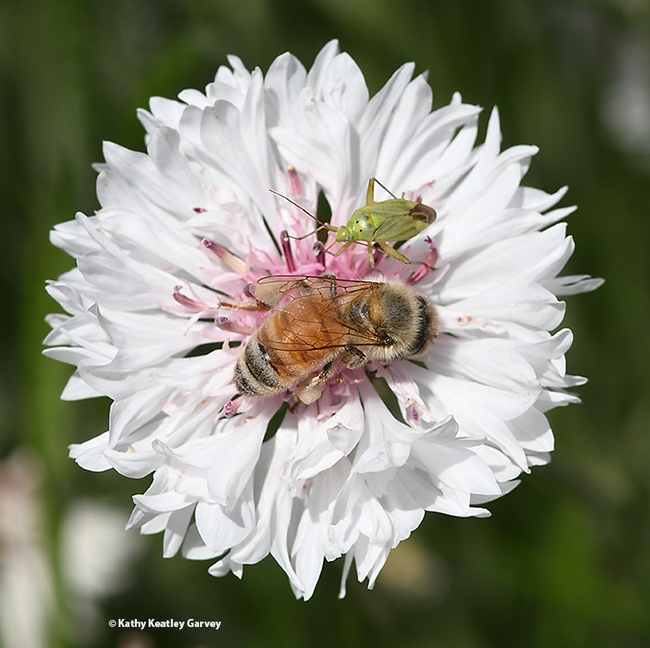
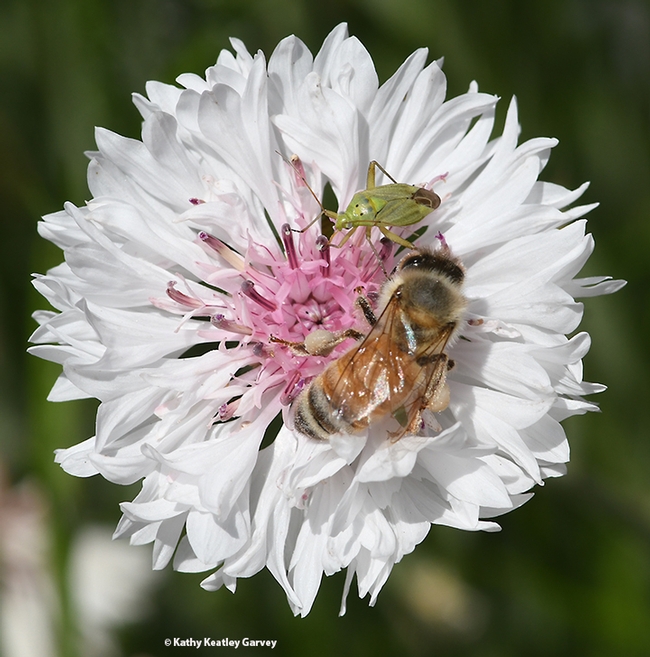
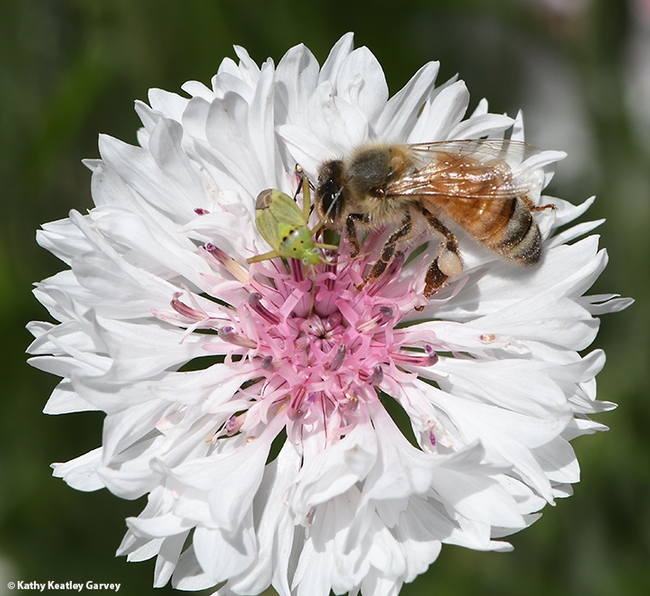
- Author: Kathy Keatley Garvey
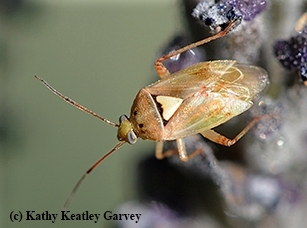
Agricultural entomologist Emily Bick is targeting you.
Lygus hesperus, a serious pest of strawberries--as well as cotton, and seed crops such as alfalfa--causes an estimated $40 million in annual losses to California's strawberry industry.
Bick, who received her doctorate in entomology last year from UC Davis and is now a postdoctoral fellow at the University of Copenhagen, is a newly selected recipient of an American Association of University Women (AAUW) American Publishing Grant and her subject is the lygus bug immigration and aggregation in California strawberries.
The $6000 grant is designed to support women over a two-month period in the summer as they prepare a solo-authored manuscript.
Bick's application focused on her scientific modeling work that originated from her Ph.D. program. Her application detailed the academic women who supported her career, including one of her mentors, Cornell University entomology professor Laura Harrington. Additionally, women students she mentored while at UC Davis provided letters of support.
“Prior to receiving this good news, my fiancé, Nora Forbes, and I decided to get married in the historic home of the AAUW in St. Paul, Minn.,” Bick said. “We are both aware of AAUW's legacy of supporting women in their academic pursuits since 1881 and wanted to celebrate in a location in line with their pioneering vision.” Forbes is a statistician at the Danish Medtronic office.
Earlier this year, Bick received a $23,000 fellowship from the American Scandinavian Foundation for her proposal, "Designing Pest-Resilient Apple Orchards Using Bespoke Models." The project will start immediately following the AAUW grant.
As a postdoctoral fellow at the University of Copenhagen, the UC Davis alumnus is a member of Professor Lene Sigsgaard's research team. She received a $244,000 postdoctoral grant from the Danish Innovations Fund to estimate insect population dynamics in relation to FaunaPhotonics's LIDAR insect sensor. LIDAR stands for light detection and ranging.
Emily's entomological journey began at Cornell University, where she received her bachelor's degree in entomology in 2013. She then received two degrees in entomology from UC Davis: her master's degree in 2017 and her doctorate in 2019.
Bick, who specializes in integrated pest management, helped anchor the UC Davis Department of Entomology and Nematology's Linnaean Games Team that won the national championship at the Entomological Society of America (ESA) meeting in 2016, and the University of California (UC Davis and UC Berkeley) Linnaean Games Team that won the national championship in 2018. The Linnaean Games, launched in 1983, are lively question-and-answer, college bowl-style competitions on entomological facts and played by winners of the ESA branch competitions. The teams score points by correctly answering random questions. (Watch the championship game on YouTube).
While at UC Davis, Bick served as vice president of the UC Davis Entomology Graduate Student Association (EGSA). ESA honored her as a Board-Certified Entomologist in 2014, and the Student Certification Award in 2018. She served as an emergency medical technician from 2008 to 2017.
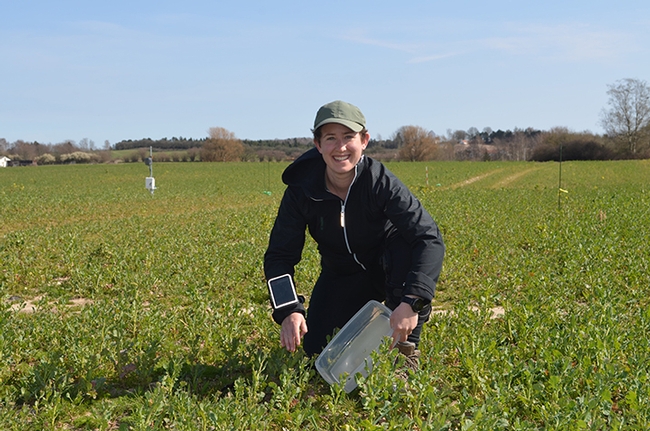

- Author: Kathy Keatley Garvey

A crab spider nailed a major pest, a lygus bug, Lygus hesperus. It's something you don't see very often. But you appreciate very much.
A lygus bug made the fatal mistake of feeding on a blanket flower (Gaillardia) where the cunning spider was lurking and waiting for prey...er...dinner.
A venomous bite and it was all over.
The lygus bug is easily distinguishable by its triangle or V shape on its back. The V does not stand for "Victory" when it's attacked and consumed by a crab spider.
Do not feel sorry for lygus bugs. Their piercing mouthparts suck the lifeblood (juices) right out of the plant tissues. You may have seen them feeding on berries, beets and beans. The females lay their eggs in the plant tissues. Their visible path of destruction ranges from discoloration and deformation to leaf-curling and lesions.
"Lygus bug adults are about 0.25 inch long and 0.1 inch (2.5 mm) wide, and flattened on the back," according to the UC Statewide Integrated Pest Management Program (UC IPM). "They vary in color from pale green to yellowish brown with reddish brown to black markings, and have a conspicuous triangle in the center of the back. Nymphs resemble adults, but are uniformly pale green with red-tipped antennae; larger nymphs have five black spots on the upper body surface. Nymphs do not have wings." (Read UC IPM Pest Management Guidelines for more information and how to control them.)
The some 200 host plants of lygus bugs include Russian thistle, wild radish, London rocket, black mustard and goosefoot.
Their enemies are many. "A parasitic wasp, Anaphes iole, which attacks lygus eggs, is available commercially and can be used for inoculative releases," UC IPM says. "It can reduce lygus populations in strawberry fields; but because thresholds for this pest are very low and adults moving into the field from external sources are not controlled, economically acceptable results may not be achieved. Naturally occurring predators that feed on the nymphal stages of lygus bug include bigeyed bugs (Geocoris spp.), damsel bugs (Nabis spp.), minute pirate bugs (Orius tristicolor), and several species of spiders."
Spiders? Yes, indeed.
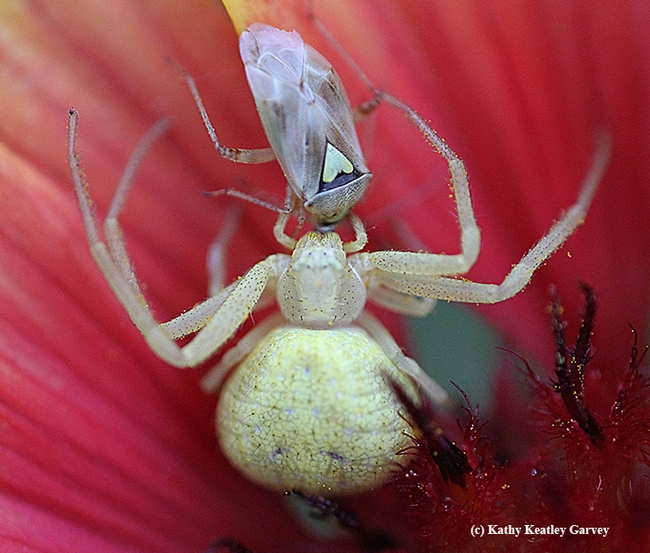
- Author: Kathy Keatley Garvey

This major agricultural pest is one of the causes of those cat-faced strawberries you see in your garden or in the field. Cat-faced? Think misshapened, deformed or irregularly shaped berries.
Catfacing occurs when the young seeds (achenes) fail to stimulate the fruit (receptacle) to grow.
Lygus bugs attack herbs, vegetable crops, commercial flower plants, fruit trees and nursery stock.
Enter Frances Sivakoff, doctoral candidate in entomology at UC Davis. She'll discuss her research on lygus bugs from 12:10 to 1 p.m., Wednesday, Oct. 19 in 122 Briggs Hall, UC Davis.
Her topic: "Pest Management from a Landscape Perspective: Understanding the Factors that Influence the Distribution of Lygus hesperus.”
Sivakoff, who studies with major professor Jay Rosenheim, investigated the dispersal ability of lygus bugs. Her results support the “already established importance of safflower, alfalfa, cotton and uncultivated agricultural land on Lygus population dynamics."“
Her research also "demonstrated the importance of several other crops in California’s San Joaquin Valley that have not traditionally been considered for the management of Lygus."
Entomology professor James R. Carey plans to webcast the seminar and then post it online on UCTV.
So soon, coming to a computer near you, lygus bug research!

- Author: Kathy Keatley Garvey

Sivakoff (right), a doctoral candidate in the UC Davis Department of Entomology, won a 2010 Robert and Peggy van den Bosch Memorial Scholarship for her work on the regional movement of the pest.
The lygus bug (Lygus hesperus) is a serious pest of such crops as alfalfa, strawberries and cotton.
Her research? "Understanding the Relative Dispersal Ability of Lygus hesperus and Its Predators Using a Novel Large-Scale Mark-Capture Technique."
“In California’s Central Valley, Lygus hesperus is under poor biological control despite a suite of known predators,” said Sivakoff, who studies with major professor Jay Rosenheim. “One possible explanation for this poor performance in the field is a discrepancy in the dispersal ability of the pest and its predators. To examine this directly, we performed a large-scale mark-capture experiment where we marked L. hesperus and its predators in an alfalfa field using protein markers.”
Following the marking procedure, the grower harvested the alfalfa field, and this prompted a dispersal event. At several times following the harvest, Sivakoff and colleagues sampled surrounding cotton fields for L. hesperus and its predators, including big-eyed bugs (Geocoris spp.), damsel bugs (Nabis spp.), green lacewings (Chrysopa and Chrysoperla spp.), and convergent lady beetles (Hippodamia convergens).

His project: “Investigating Host-associated Lineage Splitting within Dactylopius Using Molecular Phylogenetics.”
Van Dam studies with major professor Bernie May of the UC Davis Department of Animal Science.
Sivakoff and Van Dam were among eight University of California doctoral candidates sharing a total of $95,000 as recipients of the scholarships.
The recipients are all involved in biological control, said coordinators Kent Daane and Nicholas Mills, co-directors of the Center for Biological Control, UC Berkeley. Eligible to apply for the annual scholarships are doctoral candidates from UC Davis, UC Berkeley and UC Riverside. Selection is by a panel of biocontrol faculty representing the three schools.
The other recipients of 2010 van den Bosch scholarships:
Albie Miles, UC Berkeley, for "Evaluating the Influence of Floral Resource Provisioning on Biological Control of Leafhoppers and Mealybugs in California Vineyards." Major professor: Miguel Altieri.
Steve Bayes, UC Berkeley, for "Determining the Population Structure of Navel Orangeworm (Amyelois transitella): an Invasive Agricultural Pest in California." Major professor: Steve Welter.
Jason Mottern, UC Riverside, for his work on molecular relationships within the parasitic wasp family, Aphelinidae. Major professor: John Heraty.
Jamie Gonzalez, UC Riverside, "Genetic Effects of Prolonged Mass Rearing on Trichogramma pretiosum Fitness: Inbreeding Depression and Selection for Adaptation the Mass Rearing Conditions." Major professor: Richard Stouthamer.
Casey D. Butler, UC Riverside, "Assessment of the Potential for Biological Control for Management of Bactericera cockerelli (Hemiptera: Triozidae)." Major professor: John Trumble.
Jennifer Henke, UC Riverside, for his work dealing with t secondary impacts on fish. Major professor: William Walton.
Congratulations to them all!
